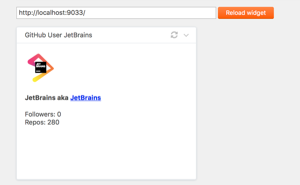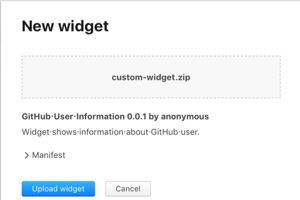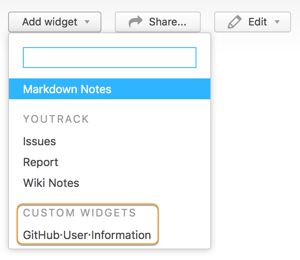Custom Widget Tutorial
This page shows how to build a custom widget. We decided to cover a very simple case: A sample widget that displays profile information of a predefined GitHub user. This widget does not perform any complex operation, like authentication and authorization in a third-party service, nor does it have complex style elements. Still, we hope that it will give you the taste of how the idea of custom widgets works.
The outline of the developing a custom widget contains the following steps:
Describe the widget with the manifest.json
Create an entry point for your widget: index.html file
Create the script: index.js
Test the widget
Upload the widget to your dashboard.
Create the manifest
As the first step, we create the manifest.json file. This file defines the attributes for the custom widget.
For YouTrack Standalone to read and display the attributes in the widget manifest:
The file must be named
manifest.json.The file must be stored in the top-most level of the ZIP archive.
Here is the manifest file for our sample widget:
{
"key": "github-user-widget",
"version": "0.0.1",
"name": "GitHub User Information",
"description": "Widget shows information about GitHub user.",
"author": "anonymous"
}Create index.html
Second step is to create an entry point for your widget: index.html file. This is a standard HTML5 file that includes the hub-dashboard-addons library that allows communicating with the dashboard. It also contains CSS styles to display the data retrieved from the GitHub profile. The body element includes the widget script itself (index.js).
<!doctype html>
<html>
<head>
<meta charset="utf-8">
<!-- Default styles of dashboard widgets -->
<link rel="stylesheet" type="text/css" href="https://unpkg.com/hub-dashboard-addons@latest/dashboard.css">
<!-- Include dashboard connector from CDN -->
<script src="https://unpkg.com/hub-dashboard-addons@latest"></script>
<style>
.user-avatar {
width: 64px;
height: 64px;
}
</style>
</head>
<body>
<div id="user-details">Loading...</div>
<script src="index.js"></script>
</body>
</html>Create the script
The third step is to create the script itself. In our case, the script retrieves and displays the user profile of a specified GitHub user.
/* Declare a constant that contains a login of the target github user */
const USER_NAME = 'jetbrains';
/* The following renderUserDetails(user) function creates and inserts the user profile data into the DOM */
function renderUserDetails(user) {
const container = document.getElementById('user-details');
container.innerHTML = `
<img src=${user.avatar_url} class="user-avatar"/>
<h4>${user.name} aka <a href="${user.html_url}">${user.login}</a></h4>
<div>
<div>Followers: ${user.followers}</div>
<div>Repos: ${user.public_repos}</div>
`;
}
/* The following function actually retrieves the data from GitHub using the GitHub API.
It uses the Fetch API (https://developer.mozilla.org/en-US/docs/Web/API/Fetch_API) */
function loadAndRenderUser(userLogin) {
return fetch(`https://api.github.com/users/${userLogin}`)
.then(response => {
return response.ok ? response.json() : new Error(response);
})
.then(user => {
renderUserDetails(user);
return user;
})
.catch(err => console.warn(err));
}
/* The last step is to register the widget in the dashboard and initiate loading the user data.
Also, this block defines displayed widget title and adds the refresh button.
When you click the refresh button, the script will reload and re-render the user profile data.
We use Dashboard API to implement this functionality. */
// Register widget:
Dashboard.registerWidget(function (dashboardAPI, registerWidgetAPI) {
// Load GitHub profile data
loadAndRenderUser(USER_NAME)
// Set the widget title
.then(user => dashboardAPI.setTitle(`GitHub User ${user.login}`));
// Add the refresh button.
registerWidgetAPI({
onRefresh: () => loadAndRenderUser(USER_NAME)
});
});Test the Widget
To test the widget, we need to load it in the Widgets Playground. First, we run a static server on the local directory with the custom widget files. In our case, we use npm http-server that requires Node.js. To simplify the matters even more, we use a YouTrack Standalone service that is available over HTTP. If you have YouTrack Standalone running over HTTPS, then you need to host your widget over HTTPS as well. In this case, you can give a try to https://ngrok.com service. For more information, see Testing Widgets over a Secure Connection.
To load your widget in the widgets playground:
Install the http-server:
npm i http-server -g- From the custom widget directory, run the http-server with the following command: The http-server starts and serves the content on the current directory. In the response you see the IP addresses (both internal and external) at which the http-server is accessible. For example:
http-server . --cors -c-1 -p 9033
We use a locally running YouTrack service, thus we can even load the widget into the widgets playground from the
http://localhost:9033/address. Enter the web address for your custom widget in the input field. In our case,
http://localhost:9033/- Click the Load widget button.
If you modify the code and upload these changes to your web server, use the Reload widget button to refresh the widget content and test the updates.
Upload the Widget
Now that we successfully tested the widget in the playground, we can upload it to the production environment.
First, we create a zip archive with the widget files. You can use any archive application to your liking. Just remember that manifest.json and index.html files must be located on the top-most level of the zip file.
For example, we used command line prompt in Mac OS X to create the archive. Our sample widget contains only three files and all of them are located in the same directory without any subdirectories. Thus the command to create the archive is very simple (run in the custom widget directory):
zip custom-widget.zip *We created the custom-widget.zip file. Now we just need to upload it to the production environment:
This it! Now the new custom widget is available to the users of the Dashboard in YouTrack Standalone.



